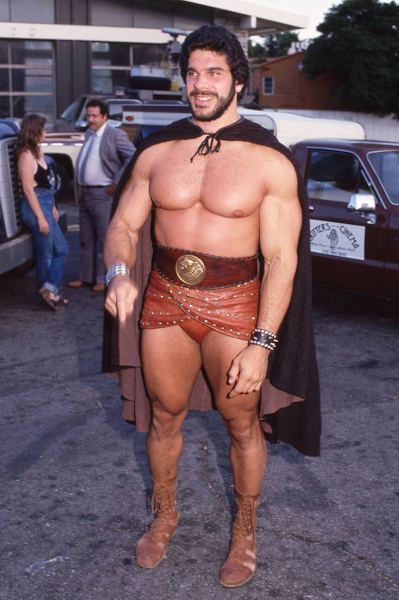Costume Design by Adriana Spadaro
Luigi Cozzi's footloose adaptation of the Labours of Hercules played with more comic book and pulp scifi imagery than the various Italian peplum films that preceded it, or the various sword & sorcery films it was released amidst, such as the previous year's Conan the Barbarian.Adriana Spadaro's costume designs for Hercules reflect the pulpy vibe, with the costumes ranging from typical ahistorical fantasy fare, to more 'space age' feeling costumes. The studded leather loincloth worn by Lou Ferrigno is a classic 'peplum' look updated for the 1980s.
A golden armor bodice was also designed for Mirella D'Angelo as Circe, the bodice and boots fitted with blue fabric tassles. In an earlier appearance, a tattered robe, split into two sides of fabric colours, is worn as part of Circe's guises as an old crone. The costume is completed with a sculpted headdress. A more 'Orientialist' dress, pastiching classic Middle Eastern clothing was designed and made for Ingrid Anderson as Cassiopea, with a white veil complimenting the look. Another, much more racey feeling dress was made for Anderson in the Minos palace scenes, consisting of a shiny collar with strips of fabric trailing around her body; the nipples are covered with plastic clamshells. A special crown was also made.(I am assuming, due to the film's relative budget and ambition, that all the crowns, tiaras and armor was actually made for the film (though presumably made out of plastic rather than metal) and not just borrowed from earlier peplum films).
Various tunics in different colours and patterns were made for the extras playing guards. The Theban guards in the film's opening wear powder blue tunics with white panelling around the edges, while the captain's wear tunics of deeper blue with white panelling and red piping. The guard commander is differentiated with his tunic having more panels of white fabric on the bottom half. At least two of the captain costumes were reused by Spadaro in the opening scene of The Adventures of Hercules. The Minos guards in the film's finale wear black tunics with speckled panelling over the edges, and are worn with vinyl capes; the tunics and capes were reused by Spadaro to clothe extras playing 'Eurac' soldiers in Sergio Martino's dirt-cheap and dreary 2019: After the Fall of New York, possibly weathered to make the speckled panelling appear darker. An orange vinyl tunic and kilt were made for William Berger as as the tyrant Minos, the tunic adorned with a tan cape and no doubt plastic 'armor' painted to resemble gold or brass. The costume was worn again by Berger in the sequel The Adventures of Hercules. Sybil Danning starred as the villainess Ariadne, wearing a skimpy dress resembling a leotard with holes cut to show off the breasts. It is worn with gold boots a dark blue cloak Spadaro designed a second dress for Danning, a blue and orange design heavily influenced by ancient Minoan clothing - the costume is mildly inaccurate, because despite amply showing Danning's bosom it's still not full frontal nudity! The dress is completed with a skirt of cut up streamers of fabric. The film's action regularly cuts to the gods Zeus, Hera and Athena, portrayed respectively by Claudio Cassinelli, Rossana Podesta and Delia Boccardo. Spadaro designed a pair of contemporary-feeling and rather futuristic feeling dresses for Podesta and Boccardo, both of them fitted with translucent fans and panelling. For Cassinelli, Spadaro designed a white robe with thick tubing all over and foam green panels and lining. Spadaro designed perhaps the most camp costume of all for Eva Robbins in her turn as Dedalos, consisting of a spandex bodysuit with teal chest plating and codpiece, a wide-collared shiny cape, and a helmet adorned with wings. The costume was worn again by Robbins in Cozzi's follow-up The Adventures of Hercules.























